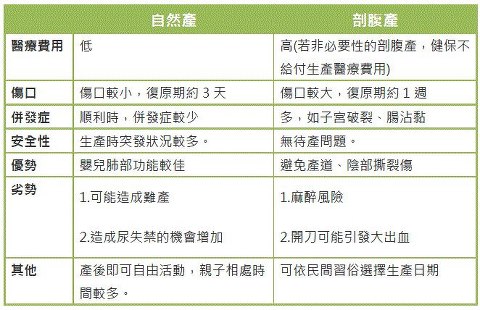Birth Comparison - Caesarean & Natural
When it gets closer to perinatal period, the parents-to-be are always torn between ways to give birth – whether it is better natural or Caesarean? Literally, natural birth is the most “natural” way to give birth, just that some aftermath is hard to predict. Chinese proverb has it, “if one gets through it (giving birth), everybody will smell the aroma of chicken wine (for the recovery of the mother); conversely, coffin is the destiny!” Birth problems are relatively easier to control in Caesarean birth, but the likelihood of complications will also increase. Then which birth method is best for mothers and babies? Why is birth by cutting the belly open called Caesarean? Although the Neanderthals in ancient Europe coexisted with modern people for a long period of time, they did not transfer any gene segment factors to the human beings today. There is a saying that mestizos could cause dystocia due to the mismatch of their skull shapes and their mothers’ pelvises, and thus leading to their extinction as they were not able to survive. To save the lives of fetuses in case of dystocia, people would cut open the bellies of mothers and took out the babies directly. However, the survival rates of mothers in early Caesarean births were extremely low. The most famous ancient who was born through cutting the belly open should probably be King Caesar of the Roman Empire! This is the reason why giving birth through a belly operation is called a Caesarean birth. Nevertheless, not all the children born through Caesarean can become the president of the country! Medical advancement leading to lower risk in Caesarean birth In the old days, mothers were usually not able to survive after giving birth in Caesarean ways. Therefore, Caesarean methods were applied only when the mothers did not have a chance to live. However, with the advancement of asepticism and the universality of blood banks, not only can Caesarean sections nowadays save the lives of fetuses, but they can also maintain the lives of mothers; coupled with the more extensive use of antibiotics, Caesarean births have developed from extra-peritoneal to intra-peritoneal, and further to transverse incision at the lower uterine segment. The saying “Caesarean birth once, caesarean birth forever” is beginning to be challenged. Generally speaking, if there is no urgent issue or immediate medical problem of the mother and the baby, one can consider giving birth naturally. With the reduced family sizes nowadays, and the increased life span average of women, are surgical operations for non-disease-based treatments more beneficial to women? This is the topic frequently raised for discussion or debate. In the end, how should we make a choice? It is suggested that pregnant mothers communicate with their obstetricians and choose an approach that suits them best. Why Caesarean Birth? 1. Malposition of fetus or complication, etc. If complications or sudden medical issues arise on either the mother or the baby before delivery, an ad hoc decision will be made to change the delivery approach to Caesarean. Examples of these issues include: fetal distress, labour hysteresis, placentaprevia, premature separation of placenta, fetus malposition, prolapse of cord, failure in birth hastening, active herpes simplex, Caesarean birth of previous baby, previous uterine surgery, diffusive genital warts of vagina and labium, curable fetal abnormalities, serious preeclampsia, overweight (below 1500g) or underweight (above 4000g) of fetus, pelvic deformity, asymmetric fetal head and pelvis, obstruction of birth canal, serious medical illness, etc. The above medical issues or complications will require Caesarean operation for baby delivery, and most of them are not detectable before labour. Therefore, often times the change of delivery method is decided at the spot as the situation requires it. 2. Avoiding the injuries of babies due to vaginal procreation What are benefits of Caesarean birth? The forefront advantage is the avoidance of fetal injuries due to vaginal birth. Some mothers choose Caesarean birth because of this reason. However, they have overlooked the fact that the chance of immature lung development of babies is higher; also brachial plexus injury and cerebral palsy are not avoidable. Therefore, Natural birth or Caesarean birth each has its benefits and shortcomings. 3. Reducing the pain caused by vaginal procreation Caesarean birth can reduce the unforgettable pain during the delivery process, and this might be that reason why many pregnant mothers choose the operation. However, with the advancement and availability of labour pain reduction technologies, mothers during the labour process can still remain graceful, and do not experience too much pain nor look embarrassed. Although the painkillers can help a little bit, the pain caused by Caesarean section can affect the normal activities after the operation. Moreover, it takes more than more week to recover after Caesarean; although post-birth eating (of mothers) and baby breast-feeding are not restricted, the pain will still affect the abilities of the mothers in taking care of the newborns. More Cases of Complication in Caesarean Birth The main harm of Caesarean birth is that the maternal mortality rate is 2~3 times higher than natural birth, and it is easy to cause bleeding, infection, injuries of bladder or digestive channel (stomach and intestine). The chance of internal organ injuries is very low in the first Caesarean birth, but when pregnant again, there is a chance of the placenta being embedded in the scar of the cut. There is a case this year: a mother went for Caesarean birth for the first pregnancy, and successfully gave birth to the second baby in the same way. However, in the third pregnancy, due to placenta increta, the cut that went through the uterus impinged the bladder, and she was forced to have the baby taken out through Caesarean at the 30th week. Despite all the medical remedies, the mother lost over 5,000cc of blood. If she chose to try natural birth for the second baby, the chance of the rupture of uterus might increase; whereas a second Caesarean birth might lead to the laceration of bladder and bowel adhesions after multiple operations. Although there are products that can help to reduce infection, it is not 100% avoidable. The above issues are not very common, but they are also unpredictable. There are relatively more cases of complication in Caesarean births, including the increased chance of the flab of vagina and pelvis; also the likelihood of the following will go up: risk of anesthesia, inflammation of cut, infection, rupture of uterus, injury of bladder. Moreover, it is easy to cause bowel adhesions. Comparatively, there are fewer complications in natural birth. The most common problem is urinary incontinence. Even urinary incontinence is not life-threatening, it may cause much inconvenience in social lives. Besides natural births, there are others reasons leading to urinary incontinence: multiple pregnancy, rapid increase in weight during pregnancy, the fetus being too heavy, etc. Therefore, for any reason if the chance of the use of Caesarean methods is increased by three times, that of decease in urinary incontinence is only 4%. Natural Birth Enjoy the intimate touch with the baby Natural Birth is a method that one is born with the ability to use. So long as the position and the size of the fetus are normal, and the mother has no other problems, whether you choose to give birth in the hospital with the help of a doctor or delivery the baby at home through a midwife, you can get the birth experience you have longed for. The recovery after birth is faster, too. Normally, the chance of needing the help of a doctor is higher in the delivery of your first baby. Nevertheless, even you need the assistance of vacuum extraction or forceps, the possibility of immediate contact with the newborn is higher than in Caesarean births, and thus the birth experience gained is much better. The hazard of natural births is that if the process does not go smoothly, Caesarean birth will be necessary. Otherwise, the baby may have problem. This is why sometimes we hear sad news in some cases in which the mothers choose to give birth at home with the involvement of midwives or a different, uncommon delivery method. During the process of natural birth, mothers will probably have pelvic injury and the injuries caused by the rupture of the vagina, bladder and anus, but serious complications such as amniotic fluid embolism is much less likely to happen. Fast recovery in natural birth The problem in birth through vagina lies in the possibility of rupture of external anal sphincter and the formation of anal and vaginal fistula. However, the chance of birth canal injuries will drop during the delivery of the second baby. Compared to Caesarean birth, the cut in natural birth is smaller, and the mother can be released from the hospital in about 3 days. Furthermore, she can get off the bed to walk and eat after giving birth. With the trend of smaller families nowadays, which method (Caesarean or natural) is better? With the level of medical advancement now, both are safe methods. For those mothers who have no medical issues but choose Caesarean birth, there is no one method with absolute advantage. However, if they choose Caesarean, they will have to pay the extra costs not covered by their insurance policies. If one plans to have more than one child, vaginal birth, if possible, is better. If pregnant mothers have any questions, they should discuss with their obstetricians before making their decisions. A perfect birth experience can be achieved only with professional opinions.
|
|

















